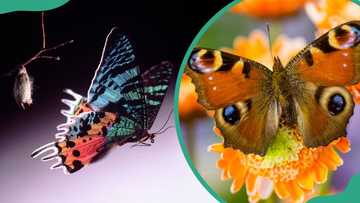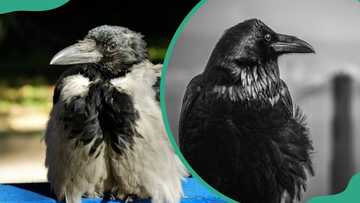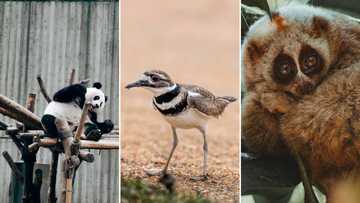20 fun facts about monkeys: interesting things about the playful primates
Monkeys are some of the most captivating and intelligent animals on the planet. These animals offer endless fascination with their unique behaviours and remarkable abilities. They are the world's largest group of nonhuman primates and include a diverse range of species. Here are some fun facts about monkeys that make them endearing to humans. Robert Sapolsky, a professor of biology, neurology, and neurosurgery at Stanford University, shares insights on unique monkey species, their playful interactions, and impressive intelligence, delving more into why these animals continue to fascinate us.
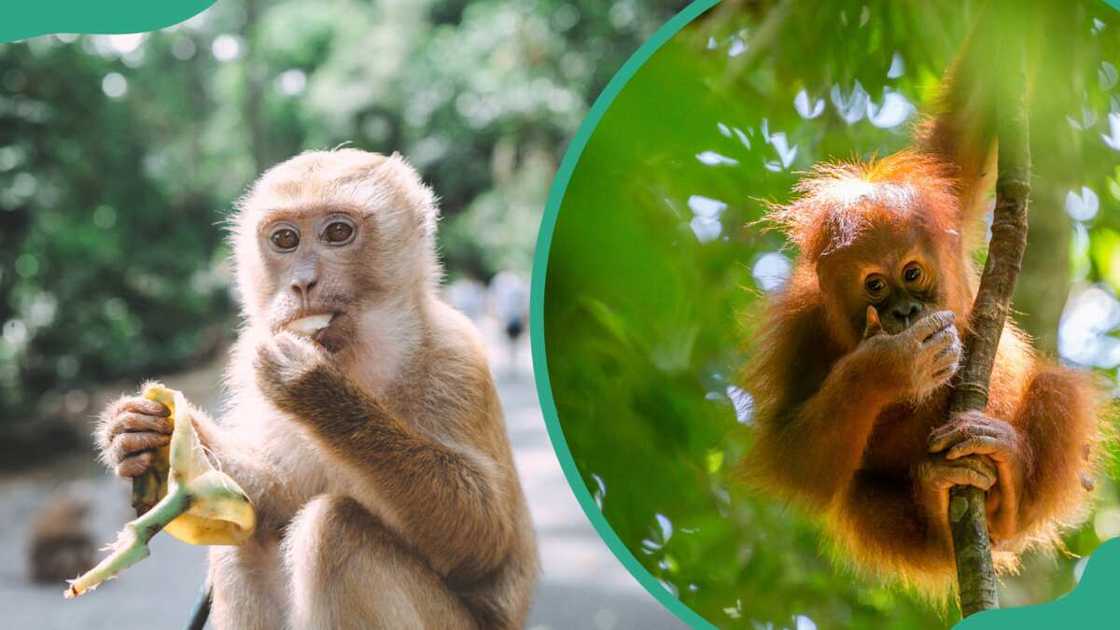
Source: Getty Images
TABLE OF CONTENTS
- What are some of the most fascinating species of monkeys, and what makes them unique?
- Can you discuss some of the playful behaviors exhibited by monkeys and what purposes they serve?
- Are there any notable intelligence or problem-solving abilities observed in monkeys?
- Fun facts about monkeys
- 1. They live both on the ground and in the trees
- 2. Illnesses can be spread to people by monkeys
- 3. Monkeys as pets are popular exotic animals
- 4. Mandrills are massive and can weigh up to 54 kilograms
- 5. They can live up to 50 years in captivity
- 6. Most monkeys have tails
- 7. They bond through grooming
- 8. They use grooming to strengthen relationships
- 9. Like young children, monkeys have a high IQ
- 10. All monkeys have opposable thumbs
- 11. The owl monkey is nocturnal
- 12. Pygmy Marmosets are the world's smallest monkeys
- 13. Howler monkeys are the loudest
- 14. The Patas monkey is the fastest primate
- 15. They have distinct fingerprints
- Disturbing facts about monkeys
- What is special about monkeys?
- What are some fun facts about monkeys for kids?
Almost all monkeys live in troops consisting of several females with young and either a single male or several males. These intelligent animals are grouped into two main groups: Old World and New World monkeys. Old World monkeys have narrow, downward-facing nostrils, while New World monkeys have broader, side-facing nostrils.
What are some of the most fascinating species of monkeys, and what makes them unique?
In an interview, Robert Sapolsky, a professor of biology, neurology, and neurosurgery at Stanford University, said that the bonobos are one of the most fascinating primate species. He explained:
As a primatologist, I think all primates are fascinating and unique. But if I had to choose one, it would be bonobos (who are apes rather than monkeys—apes are humans, chimps, orangutans, gorillas, and gibbons). Bonobos are very closely related to chimpanzees and share 99% of their DNA with them. And you could not find two species that behave more differently.
Chimps are highly aggressive, have organized violence between groups that looks a bit like 'war,' and are entirely dominated by males. All of that is different in bonobos — females dominate, there are very low levels of aggression, and everyone is constantly having sex with each other. They evolved to be so different.
Can you discuss some of the playful behaviors exhibited by monkeys and what purposes they serve?
Dr. Sapolsky explained that playing serves various social and developmental purposes in every monkey's life. He said:
When young monkeys are playing with each other by wrestling, it looks so much like humans, and they are enjoying it. Among baboons, it is a place where there is a little bit of democracy — you take a young monkey who is the child of a high-ranking female and one whose mother is low-ranking, and in the rest of life, the first one's family completely dominates the second one. But when the two kids play wrestling, they are much closer than usual to being equals.
Are there any notable intelligence or problem-solving abilities observed in monkeys?
Dr. Sapolsky shares some significant cognitive abilities observed in apes and monkeys. He highlights:
There is one amazing example in chimpanzees. It is a memory task that chimps get right about 90% of the time, while humans are more like 10%. It involves being shown a pattern for only a few seconds, and chimps have something resembling photographic memory—they instantly see the entire thing.
Another interesting example is seen among monkeys. It has to do with this property in math called 'transitivity'—it is how you can know that Object 1 is bigger than Object 2, and if Object 2 is bigger than Object 3, then you automatically know that Object 1 is bigger than Object 3. Very young kids have a lot of trouble understanding this.
Very clever experiments have been done with monkeys and things like blocks of wood of different sizes, and what you see is that they cannot understand transitivity.
But now, you put the monkey in this situation: it watches two other monkeys and sees that Monkey #1 is socially dominant to Monkey #2. Our monkey has already interacted with #2 and knows he is lower ranking than him. Therefore, you introduce our monkey to #1, and our monkey immediately gives a gesture showing that he knows he is low-ranking.
The monkey can understand, 'If Monkey #1 is higher-ranking than #2, and #2 is higher-ranking than me, then I already know that #1 is higher-ranking than me.' In other words, monkeys cannot understand transitivity regarding physical objects but can understand it regarding social behavior.
Fun facts about monkeys
Monkeys are known for their playful antics, social bonds and problem-solving skills. These wild animals provide a window into the complexities of animal intelligence and social structures. Below are various fun and intriguing facts that highlight their unique nature.
1. They live both on the ground and in the trees
Monkeys live in the trees and on the ground. Their arboreal skills allow them to navigate through forests with agility, while their terrestrial abilities enable them to forage and travel over land. These animals sleep while sitting on trees. They do this for security reasons to keep away from predators.
2. Illnesses can be spread to people by monkeys
Monkeys can transmit various diseases to humans in a process known as zoonosis. These diseases include herpes B virus, simian immunodeficiency virus (SIV), and different forms of tuberculosis. Therefore, it is imperative to check on the proper handling and care of monkeys in wild and captive settings.
3. Monkeys as pets are popular exotic animals
Monkeys are often considered exotic pets due to their intelligence and playful nature. However, these animals require specialised care as they can exhibit aggressive or destructive behaviour. This character labels them as potentially dangerous pets.
4. Mandrills are massive and can weigh up to 54 kilograms
Mandrills are the largest monkeys, with males weighing up to 54 kilograms (119 pounds). Their vivid facial colouration and impressive size make them one of the most striking and formidable monkey species.
5. They can live up to 50 years in captivity
Monkeys have different lifespans depending on their species and living conditions. In the wild, they live between 10 and 30 years; in captivity, some can live up to 50 years with proper care. This longevity in captivity is due to better nutrition, medical care, and the absence of predators.
6. Most monkeys have tails
Most monkeys have tails, which they use for balance, communication, and sometimes as an extra limb. Tails are essential for arboreal species, aiding their agility and ability to navigate the treetops.
7. They bond through grooming
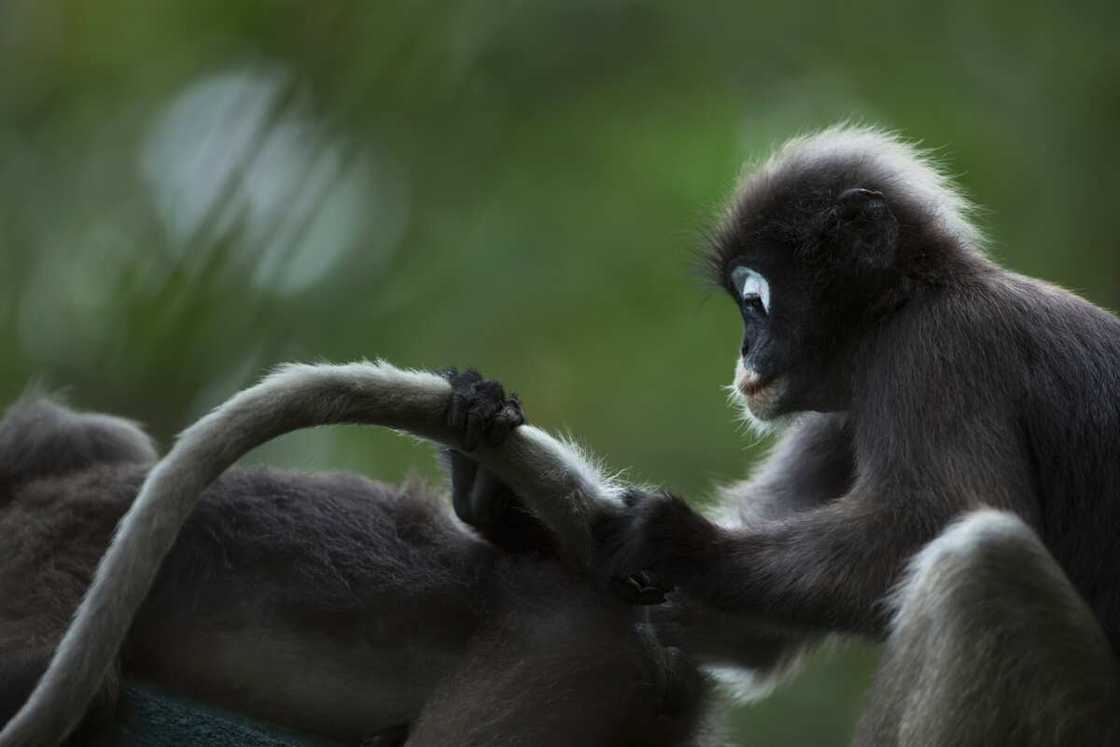
Source: Getty Images
This is one of the fun facts about monkeys for kids. Grooming is a crucial social activity for monkeys as it is used to strengthen relationships, reduce stress, and establish social hierarchies. This behaviour fosters group cohesion and cooperation, which are essential for social group survival.
8. They use grooming to strengthen relationships
The quickest way to tell the difference between a monkey and an ape is by the presence or absence of a tail. As mentioned earlier, almost all monkeys have tails, but apes do not. The primate order also includes apes, such as gorillas, chimpanzees, humans, lemurs, and tarsiers. Monkeys are just one group within this diverse and fascinating animal order.
9. Like young children, monkeys have a high IQ
These animals are brilliant, with cognitive abilities comparable to those of young children. They can learn complex tasks, use tools, and even understand basic concepts, making them fascinating cognitive and behavioural research subjects. Good examples are the Capuchin monkeys that collect palm fruits and smash them open using an anvil or hammer stone.
10. All monkeys have opposable thumbs
Like humans, monkeys have opposable thumbs. This crucial adaptation allows them to grasp objects, manipulate tools, and perform complex tasks. The opposable thumbs are a vital factor in their ability to interact with their environment and solve problems.
11. The owl monkey is nocturnal
The owl monkey, known as the night monkey, is unique for its nocturnal lifestyle. These primates have adapted to life in the dark, with large eyes that enhance their night vision, allowing them to thrive in their nocturnal niches.
12. Pygmy Marmosets are the world's smallest monkeys

Source: Getty Images
Pygmy marmosets are the world's smallest monkeys, weighing just 100 to 140 grams (3.5 to 5 ounces). Despite their tiny size, they exhibit remarkable agility and complex social behaviours, making them fascinating creatures to study. They are generally found in evergreen and river-edge forests and are gum-feeding specialists.
13. Howler monkeys are the loudest
Howler monkeys are the loudest land animals, with their calls heard up to 5 kilometres (3 miles) away. They call to let others know where their territory is, alerting them to stay away. The calls sound like a loud whooping bark or roar. These animals live in Central and South America.
14. The Patas monkey is the fastest primate
The Patas monkey (Erythrocebus patas), also known as the hussar monkey, is the fastest primate. It can run up to 55 kilometres per hour (34 miles per hour). This incredible speed helps them evade predators and cover large distances for food. Patas monkeys are found in central, western, and eastern Africa.
15. They have distinct fingerprints
Like humans, monkeys have unique fingerprints, presumably inheriting them from the group's common ancestor. These distinctive patterns are used for individual identification and testify to the intricate evolutionary similarities between monkeys and humans.
Disturbing facts about monkeys
While monkeys are often admired for their intelligence and social complexity, a darker side to their behaviour and interactions can be pretty unsettling. By exploring these unsettling aspects, you understand some of the challenges surrounding these fascinating primates. Check them out below.
1. Male monkeys kill infants when they take over a new group
Male monkeys in some species, like hanuman langurs and baboons, may kill infants when they take over a new group. This is believed to be a strategy to bring the females back into oestrus sooner, allowing the new dominant male to sire his offspring.
2. Monkeys in captivity like licking bars and walls
Monkeys in captivity often exhibit abnormal behaviours like licking bars and walls incessantly. This behaviour usually shows severe stress, boredom, or nutritional deficiencies. It highlights the psychological trauma and environmental deprivation they face when kept in unnatural settings.
3. When under severe stress, monkeys indulge in self-mutilation
In extreme cases of psychological distress, approximately 10% of captive, individually housed monkeys harm themselves by biting, scratching, or hitting their bodies. Self-mutilation is a tragic indicator of the severe mental and emotional suffering these intelligent creatures endure, especially in captivity or stressful environments.
4. Some monkeys eat or play with their faeces
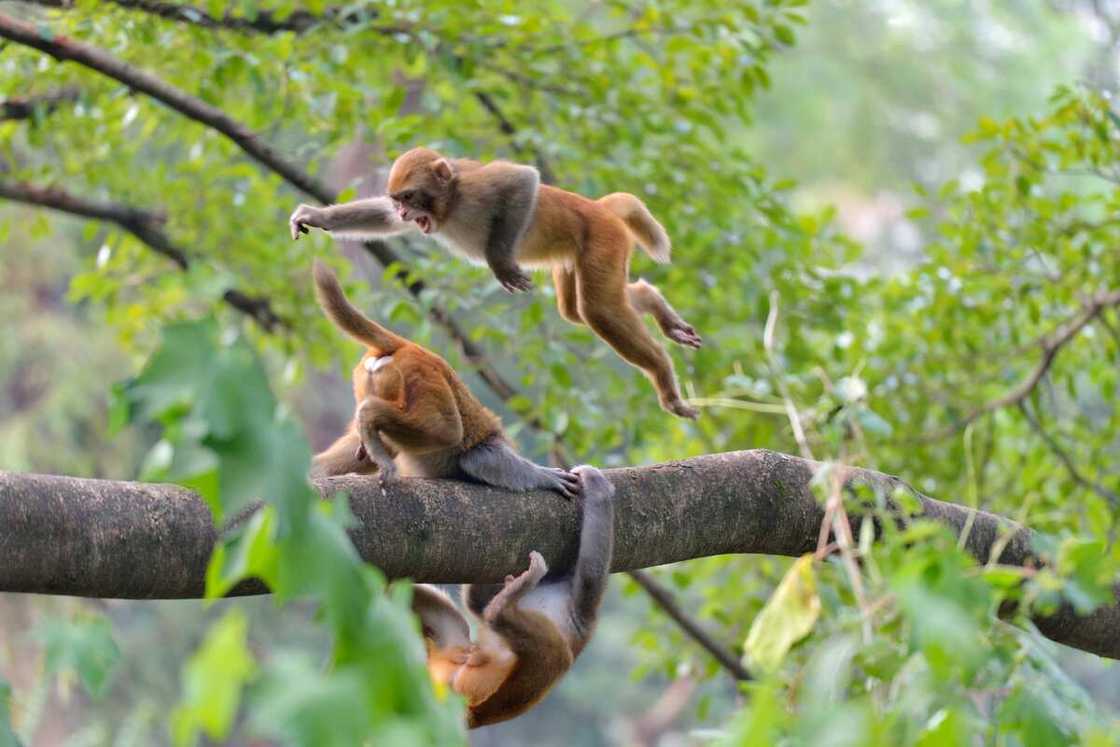
Source: Getty Images
Monkeys have been observed eating or playing with their own or others' faeces, a behaviour known as coprophagia. This disturbing activity can signify severe boredom, stress, or an attempt to gain attention. It also poses significant health risks due to the transmission of parasites and diseases.
5. In captivity, they vomit and consume the regurgitated food
Some monkeys in captivity will vomit and then consume the regurgitated food. This behaviour is often a result of chronic stress or gastrointestinal disorders. It highlights the severe impact of an unnatural and unstimulating environment on the monkeys’ well-being.
What is special about monkeys?
How are monkeys unique? Monkeys are special due to their high intelligence, complex social structures, and remarkable adaptability to various environments. These animals exhibit behaviours similar to humans, such as using tools, solving problems, and expressing emotions.
What are some fun facts about monkeys for kids?
Monkeys are fascinating animals for kids to learn about. They have opposable thumbs for grasping, are very social and groom each other to make friends, eat fruits, leaves, and insects, and range from loud howler monkeys to tiny pygmy marmosets.
These fun facts about monkeys showcase their incredible adaptability, intelligence, and social complexity. Understanding the lighter side of their behaviour and biology enhances your appreciation for these remarkable creatures and highlights the importance of their conservation.
Legit.ng recently published an exciting post about the slowest animals in the world. Slow animals live in different ecosystems that favour their speeds and protect them from fast-paced predators.
Many animals compete for the distinction of being the world's slowest. While surviving in a fast-paced ecosystem requires animals with high speeds, the sluggish creatures on this list are no less remarkable. Discover some of the top creatures who have mastered the art of moving.
Source: Legit.ng

Brian Oroo (Lifestyle writer) Brian has worked as a writer at Legit.ng since 2021. He specialises in lifestyle, celebrity, and news content. He won the Writer of the Year Award at Legit in both 2023 and 2024. Brian holds a BSc in Electrical and Electronics Engineering from Jomo Kenyatta University of Agriculture and Technology (JKUAT), earned in 2021. He completed the AFP course on Digital Investigation Techniques in 2023 and the Google News Initiative course in 2024. His email is brianoroo533@gmail.com

Mary Ugbodaga (Lifestyle Journalist) Mary Ugbodaga is a Legit.ng journalist with 7 years of experience in journalism and media communications. She graduated from Covenant University in 2018 with a Bachelor's degree in Mass Communication/Media Studies. Mary previously worked as a journalist at TheCable, CNBC AFRICA, Voice of Nigeria, KPMG Nigeria. Email: mary.ugbodaga@corp.legit.ng.


